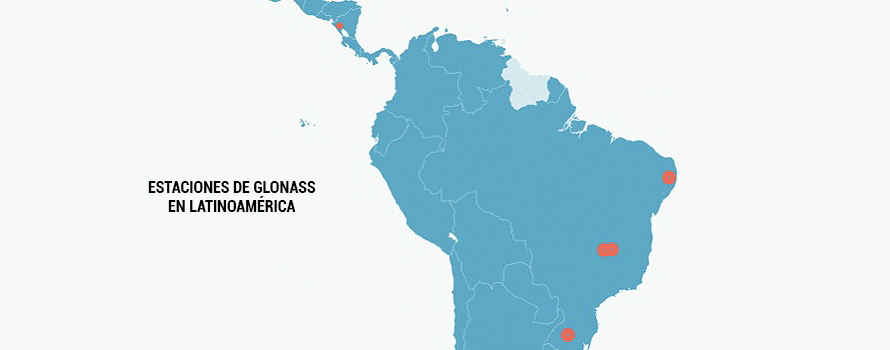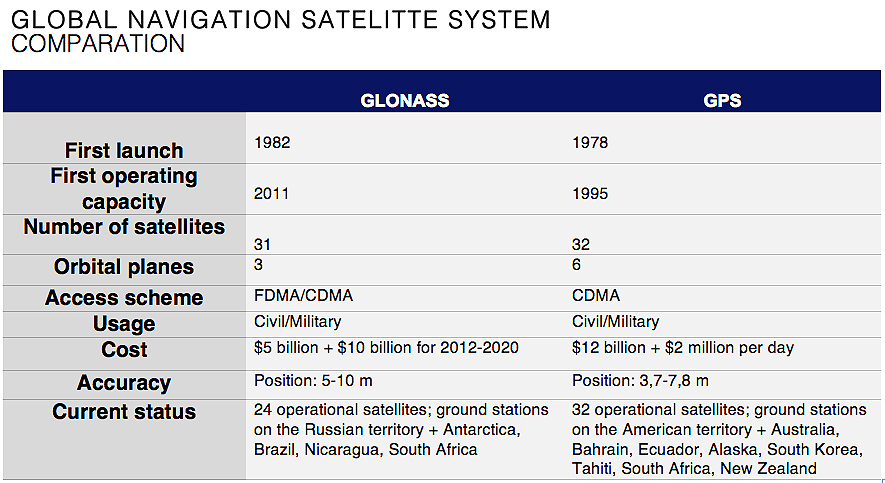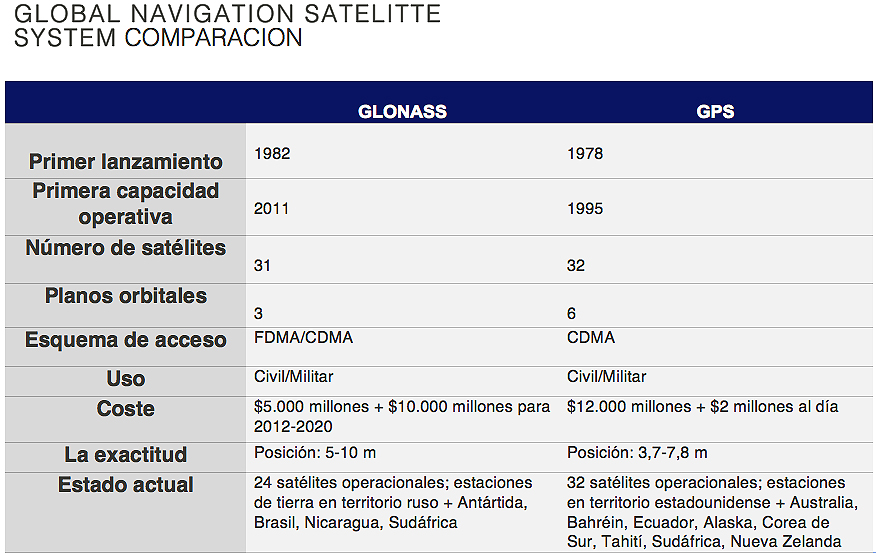Breadcrumb
Blogs
Entries with tag roscosmos .
The Russian positioning system GLONASS has placed ground stations in Brazil and Nicaragua; the different accessibility of them to nationals gives rise to conjectures
At a time when Russia has declared its interest in having new military facilities in the Caribbean, the opening of a Russian station in the Managua area has raised some suspicions. Roscosmos, the Russian space agency, has opened four stations in Brazil, managed with transparency and easy access; instead, the one that has built in Nicaragua is surrounded by secrecy. What little is known about the Nicaraguan station, strangely greater than the others, contrasts with the openly that data can be collected on the Brazilians.

ARTICLE / Jakub Hodek [Spanish version]
We know that information is power. The more information you have and manage, the more power you enjoy. This approach must be taken into account when examining the ground stations that serve to support the Russian satellite navigation system and its construction in relative proximity to the United States. Of course we are no longer in the Cold War period, but some of the traumas of those old times may help us to better understand the cautious position of the United States and the importance that Russia sees in having its facilities in Brazil and especially in Nicaragua.
That historical background of the Cold War is at the origin of the two largest navigation systems we use today. The United States launched the Global Positioning System (GPS) project in the year 1973, and possibly in response, the Soviet Union presented its own positioning System (GLONASS) three years later. [1] It has been almost 45 years, and these two systems no longer serve Russians and Americans to try to get information on each other, but are collaborating and thus offering a more accurate and fast navigation system for consumers who buy a Smartphone or other electronic device. [2]
However, in order to achieve global coverage, both systems need not only satellites, but also ground stations strategically distributed around the world. For that purpose, the Russian Federal Space Agency, Roscosmos has erected stations for the GLONASS system in Russia, Antarctica and South Africa, as well as in the Western Hemisphere: it has four stations in Brazil and since April 2017 has one in Nicaragua, which by secrecy around its purpose has caused mistrust and suspicion in the United States [3] (USA, for its part, has ground stations for GPS in its territory and Australia, Argentina, United Kingdom, Bahrain, Ecuador, South Korea, Tahiti, South Africa and New Zealand).
The Russian Global Satellite Navigation System (Globalnaya Navigatsionnaya Sputnikovaya sistema or GLONASS) is a positioning system operated by the Russian Aerospace Defence Forces. It consists of 28 satellites, allowing real-time positioning and speed data for the surface, sea and airborne objects around the world. [4] In principle GLONASS does not transmit any personally identifiable information; in fact, user devices only receive signals from satellites, without transmitting anything back. However, it was originally developed with military applications in mind and carries encrypted signals that are supposed to provide higher resolutions to authorized military users (same as the US GPS). [5]
 |
In Brazil, there are four Earth stations that are used to track signals from the GLONASS constellation. These stations serve as correction points in the Western hemisphere and help significantly improve the accuracy of navigational signals. Russia is in close and transparent collaboration with the Brazilian Space Agency (AEB), promoting research and development of the aerospace sector of this South American country. In 2013 the first station was installed, located on the campus of the University of Brasilia, which was also the first Russian station of that type abroad. It followed another station in the same place in 2014, and later, in 2016, a third was put in the Federal Institute of Sciences of the education and technology of Pernambuco, in Recife. The Russian Federal Space agency Roscosmos built its fourth Brazilian station on the territory of the Federal University of Santa Maria, in Rio Grande del Sur. In addition to fulfilling its main purpose of increasing accuracy and improving the performance of GLONASS, the facilities can be used by Brazilian scientists to carry out other types of scientific research. [6]
The level of transparency that surrounded the construction and then has prevailed in the management of the stations in Brazil is definitely not the same as the one applied in Managua, the capital of Nicaragua. There are several information that create doubts regarding the true use of the station. For starters, there is no information about the cost of the facilities or about the specialization of the staff. The fact that the station has been put at a short distance from the U.S. Embassy has given rise to conjecture about its use for phone-tapping and spying.
In addition, the vague replies from the representatives of Nicaragua and Roscosmos about the use of the station, have not managed to transmit confidence in the project. It is a "strategic project" for both Nicaragua and Russia, concluded Laureano Ortega, the son of the Nicaraguan president. Both countries claim to have very fluid and close cooperation in many areas, such as in health and development projects. However, none of those collaborations have materialized with such speed and dedication as this particular project. [7]
Given Russia's larger military presence in Nicaragua, empowered by the agreement that facilitates the mooring of Russian warships in Nicaragua announced by Russian Defense Minister Sergei Shoigu during his visit to the Central American country in February 2015, and specified also in the donation of 50 T-72B1 Russian tanks in 2016 and the increased movement of the Russian military personnel, it can be concluded that Russia clearly sees strategic importance in its presence in Nicaragua. [8] [9] This is all observed with suspicion from America. The head of South American Command, Kirt Tidd, warned in April that "the Russians are moving forward a disturbing attitude" in Nicaragua, which "impacts the stability of the region."
Without a doubt, when world powers like Russia or the United States act outside their territory, they are always guided by a combination of motivations. Strategic positioning is essential in the game of world politics. For this very reason, the aid that a country receives or the collaboration it can establish with a great power is often subject to political conditionality.
In this case, it is difficult to know for sure what is the purpose of the station in Nicaragua or even those of Brazil. At first glance, the objective seems neutral – offering higher quality navigation system and providing a different option to GPS –, but given the new importance that Russia is granting to its geopolitical capabilities, there is the possibility of more strategic use.
El sistema de posicionamiento ruso GLONASS ha colocado estaciones de tierra en Brasil y Nicaragua; las brasileñas son accesibles, pero la nicaragüense da pie a conjeturas
En un momento en que Rusia ha declarado su interés en tener de nuevo instalaciones militares en el Caribe, la apertura de una estación rusa en el área de Managua ha levantado algunas sospechas. Roscosmos, la agencia espacial rusa, ha abierto cuatro estaciones en Brasil, gestionadas con transparencia y fácil acceso; en cambio, la que ha construido en Nicaragua se ve rodeada de secretismo. Lo poco que se sabe sobre la estación nicaragüense, extrañamente mayor que las otras, contrasta con lo abiertamente que pueden recabarse datos sobre las brasileñas.

ARTÍCULO / Jakub Hodek [Versión en inglés]
Ya se sabe que la información es poder. Cuanta más información se tiene y administra, de más poder se goza. Hay que tener este planteamiento a la hora de examinar las instalaciones de estaciones que sirven para apoyar el sistema de navegación por satélites ruso y su construcción en proximidad relativa a Estados Unidos. Por supuesto que ya no estamos en el periodo de Guerra Fría, pero algunas traumas de aquellos viejos tiempos quizás nos pueden servir para entender mejor la posición cautelosa de Estados Unidos y la importancia que ve Rusia en tener sus instalaciones en Brasil y especialmente en Nicaragua.
Ese trasfondo histórico de la Guerra Fría está en el origen de los dos sistemas de navegación más grandes que utilizamos hoy en día. Estados Unidos lanzó el proyecto de Sistema de Posicionamiento Global (GPS) en el año 1973, y posiblemente como respuesta, la Unión Soviética presentó su propio sistema de posicionamiento (GLONASS) tres años después. [1] Han pasado casi 45 años, y estos dos sistemas ya no sirven para que rusos y estadounidenses intenten obtener información sobre el bando contrario, sino que están colaborando y así ofreciendo un sistema de navegación más preciso y rápido para los consumidores que compran un smartphone u otro aparato electrónico. [2]
Sin embargo, para conseguir una cobertura mundial ambos sistemas necesitan no solo satélites, sino también estaciones de tierra repartidas estratégicamente por el mundo. Con ese propósito, Agencia Espacial Federal Rusa Roscosmos ha erigido estaciones para el sistema GLONASS en Rusia, en la Antártida y en Sudáfrica, así como en el hemisferio occidental: ya tiene cuatro estaciones en Brasil y desde el abril de 2017 cuenta con una en Nicaragua, que por el secretismo en torno a su función ha causado desconfianza y sospecha en Estados Unidos [3] (EE.UU., por su parte, tiene estaciones de tierra para GPS en su territorio y en Australia, Argentina, Reino Unido, Bahréin, Ecuador, Corea del Sur, Tahití, Sudáfrica y Nueva Zelanda).
El Sistema Global de Navegación por Satélite ruso (Globalnaya Navigatsionnaya Sputnikovaya Sistema o GLONASS) es un sistema de posicionamiento operado por las fuerzas de Defensa aeroespaciales rusas. Consiste en 28 satélites, permitiendo posicionamiento en tiempo real y speed data para la superficie, el mar y los objetos aerotransportados alrededor del mundo. [4] En principio GLONASS no transmite ninguna información de identificación personal; de hecho, los dispositivos de usuarios solo reciben señales de los satélites, sin transmitir nada de vuelta. Sin embargo, fue desarrollado originalmente con las aplicaciones militares en mente y lleva señales cifradas que se supone que proporcionan resoluciones más altas a los usuarios militares autorizados (lo mismo el GPS estadounidense). [5]
En Brasil, hay cuatro estaciones de tierra que se utilizan para rastrear señales de la constelación GLONASS. Estas estaciones sirven como puntos de corrección en el hemisferio occidental y ayudan a mejorar significativamente la precisión de las señales de navegación. Rusia está en estrecha y transparente colaboración con la agencia espacial brasileña (AEB), promoviendo la investigación y el desarrollo del sector aeroespacial del país sudamericano.
 |
En 2013 se instaló la primera estación, ubicada en el campus de la Universidad de Brasilia, que además era la primera estación rusa de ese tipo en el extranjero. Siguió otra estación en el mismo lugar en 2014, y posteriormente, en 2016, se puso una tercera en el Instituto Federal de Ciencias de la Educación y Tecnología de Pernambuco, en Recife. La Agencia Espacial Federal Rusa Roscosmos construyó su cuarta estación brasileña en el territorio de la Universidad Federal de Santa María, en Río Grande del Sur. Además de cumplir su propósito principal de aumentar la exactitud y mejorar el rendimiento de GLONASS, las instalaciones pueden ser usadas por los científicos brasileños para llevar a cabo otros tipos de investigación científica. [6]
El nivel de transparencia que rodeó la construcción y luego ha imperado en la gestión de las estaciones en Brasil definitivamente no es el mismo aplicado a la abierta en Managua, la capital de Nicaragua. Hay varias informaciones que siembran dudas en relación al verdadero uso de la estación. Para empezar, no hay información sobre el costo de las instalaciones o sobre la especialización del personal. El hecho de que se haya puesto a corta distancia de la Embajada de Estados Unidos ha dado pie a conjeturas sobre su uso para escuchas y espionaje.
Además, las respuestas vagas de los representantes de Nicaragua y de Roscosmos acerca del uso de la estación, no han conseguido transmitir confianza sobre el proyecto. Es un “proyecto estratégico” tanto para Nicaragua como para Rusia, concluyó Laureano Ortega, el hijo del presidente nicaragüense. Ambos países aseguran tener una cooperación muy fluida y estrecha en muchas esferas, como en proyectos relacionados con la salud y el desarrollo, sin embargo ninguno de ellos se han materializado con tal velocidad y dedicación. [7]
Dada la mayor presencia militar de Rusia en Nicaragua, facultada por el acuerdo que facilita el atraque de buques de guerra rusos en Nicaragua anunciado por el Ministro ruso de Defensa Serguei Shoigu durante su visita al país centroamericano en febrero de 2015, y concretada también en la donación de 50 T-72B1 tanques rusos en 2016 y el movimiento creciente del personal militar ruso, se puede concluir que Rusia claramente ve importancia estratégica en su presencia en Nicaragua. [8] [9] Todo esto es vito con recelo desde EE.UU. El jefe del Comando Sur estadounidense, Kirt Tidd, advirtió en abril que “los rusos están llevando adelante una actitud inquietante” en Nicaragua, lo que “impacta en la estabilidad de la región”.
Sin duda que cuando potencias mundiales como Rusia o Estados Unidos actúan fuera de su territorio, lo hacen siempre guiados por una combinación de motivaciones. Los movimientos estratégicos son esenciales en el juego de la política mundial. Por esta misma razón, la ayuda que recibe un país o la colaboración que puede establecer con una gran potencia muchas veces está sujeta a una condicionalidad política. En este caso, es difícil saber con seguridad cuál es exactamente el objetivo de la estación en Nicaragua o incluso las de Brasil. A primera vista, el objetivo parece neutro –ofrecer calidad más alta de sistema de navegación y proveer diferente opción a la de GPS–, pero dado el nuevo valor que Rusia está concediendo a sus capacidades geopolíticas, existe la posibilidad de un uso más estratégico.
